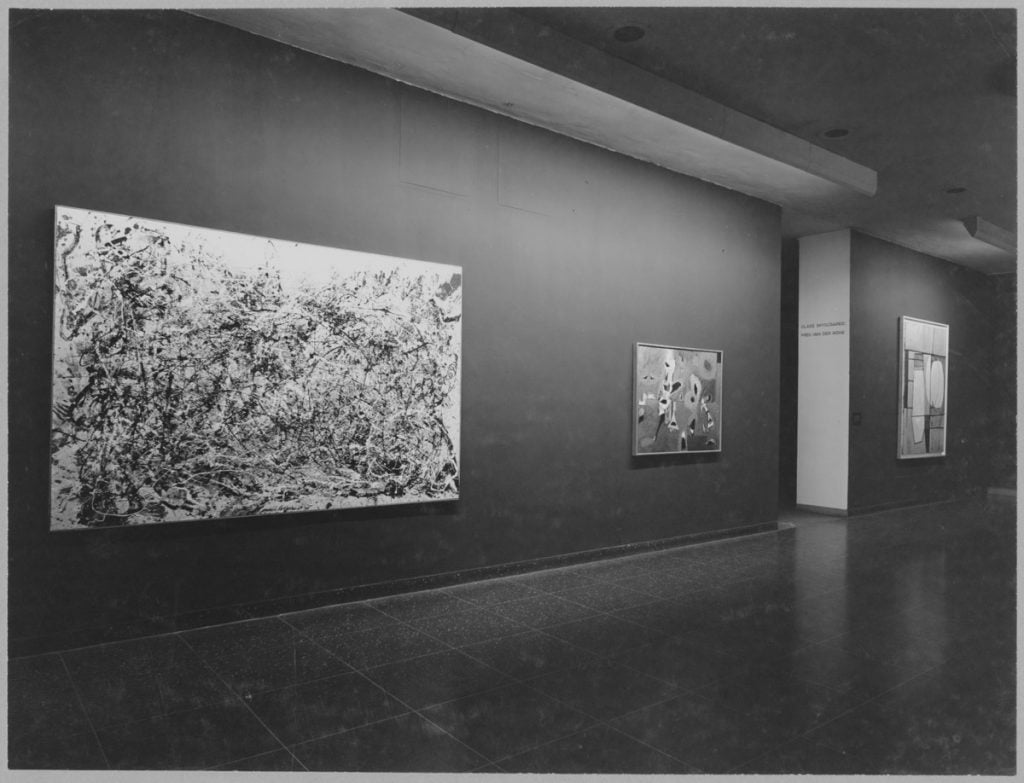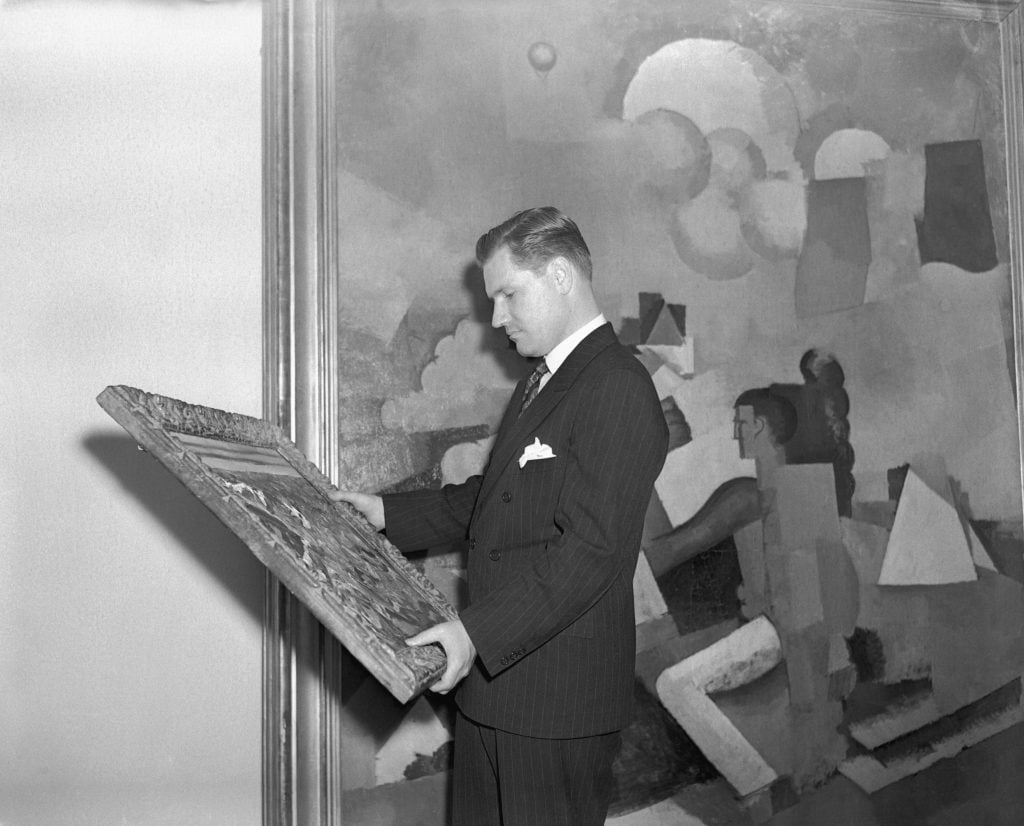When the US government established the CIA in 1947, it included a division known as the Propaganda Assets Inventory, a branch of psychological warfare intended to boost pro-American messaging during the Cold War. In the following excerpt from the new book ArtCurious: Stories of the Unexpected, Slightly Odd, and Strangely Wonderful in Art History, author Jennifer Dasal explores how the intelligence agency curated exhibitions of abstract art to wage its ideological war.
The secrecy with which the CIA pursued Abstract Expressionism was not only integral to successfully fooling the Soviet Union but also to keeping any associated artists in the dark. In [former CIA operative Donald] Jameson’s words, “[M]ost of [the Abstract Expressionists] were people who had very little respect for the government in particular and certainly none for the CIA.” Multiple artists self-identified as anarchists, particularly Barnett Newman, who was so taken by anarchism that he would later write the foreword to the 1968 reprint of Russian author Peter Kropotkin’s 1899 Memoirs of a Revolutionist, describing the anarcho-communist’s influence upon his life and work. In other words: tell Clyfford Still or Helen Frankenthaler that you wanted to use their paintings to forward a government agenda, and the answer would most likely have been a firm no.
The CIA’s answer to these problems was something known as the long-leash policy. This solution kept CIA operatives at a remove of two or three degrees from the artists and art exhibitions—sometimes even more—so that they could not be linked to any furtive governmental bankrolling. In order to fulfill this need, they elicited the participation of arts foundations, artists groups, and, most crucially, art museums, requesting their assistance in organizing special exhibitions, events, and collections. Such activity was funneled through a new arts agency created by the CIA named the Congress for Cultural Freedom (CCF), which was developed in 1950 and not revealed as a CIA project until 1966. It would always appear, then, that a museum or arts corporation was presenting and promoting Abstract Expressionism, never the government, no way! And no one was the wiser, not even the artists themselves. Especially not the artists themselves.

Installation view of “The New American Painting as Shown in Eight European Countries 1958–1959”
at MoMA. Photo by Soichi Sunami.
The museum most closely involved with the CCF’s plans for cultural domination was the Museum of Modern Art (MoMA) in New York City, focused through the participation of Nelson Rockefeller, a politician, philanthropist, and future vice president of the United States under Gerald Ford. Rockefeller and MoMA go hand in hand, as his mother was one of the cofounders of the institution, which he called Mommy’s Museum (aaargh!). He was not unfamiliar with the intelligence world either, as the former coordinator of Inter-American Affairs for Latin America during World War II, yet another propagandistic front agency.
For the CCF, then, Rockefeller’s cooperation was ideal. He used his privileged position as the president of MoMA’s board of trustees to arrange for some of the CCF’s biggest and most successful AbEx exhibitions, including the landmark 1958‒59 showcase “The New American Painting.” The exhibition was, according to its March 11, 1958, press release, “organized in response to numerous requests [to] the Museum’s International Program,” leading one to assume that other countries were clamoring for these “advanced tendencies in American painting,” rather than being coordinated through MoMA’s personnel on the order of the CIA. Under the auspices of the MoMA brand, “The New American Painting” traveled for one year straight, visiting practically every major Western European city, including Basel, Milan, Berlin, Brussels, Paris, and London. The widespread touring of the show in American-friendly countries—unlike the on-the-communist-fence locations chosen for [the State Department-funded exhibition] “Advancing American Art”—was strategic, a way to cement alliances among like-minded Cold Warriors and to promote the much-lauded cultural preeminence of the United States for the first time in history.
As with exhibitions of Abstract Expressionism in America, the responses to “The New American Painting” were mixed. The Times in London declared its showing at the Tate Gallery to be “the finest of its kind we have yet had . . . the aesthetic barometer [of] why the United States should so frequently be regarded nowadays as the challenger to, if not actually the inheritor of, the hegemony of Paris.” But art critic Georges Boudaille found the paintings to be strangely depressing and unknowable, asking in the French literary publication Les Lettres françaises, “Where does this dramatic sensation of nightmare and stain come from? What do these disturbing spatters express? What?”

Installation view of “The New American Painting as Shown in Eight European Countries 1958–1959” at MoMA. Photo by Soichi Sunami.
The Tate London showing of “The New American Painting” provides us with an intriguing case study on how the CCF operated its long-leash policy. After the exhibition opened at Paris’s Musée National d’Art Moderne in January 1959, a delegation from the Tate attended the show and was thrilled by its contents. Upon requesting an extension of the tour’s run to accommodate a London stop, the Tate cohort learned that the steep fees associated with the show were simply too pricey to accommodate, and disappointedly accepted their art-less fate. But behold! What happened next? An art- loving American millionaire named Julius “Junkie” Fleischmann appeared, almost as if by magic, and ponied up the funds. The show, happily, then continued on to London.
A fairy godfather materializes and bankrolls a major exhibition in a foreign country simply for the love of art? How magnanimous! By now, though, we know the real story: the money provided to travel the show to the UK wasn’t actually Fleischmann’s but cash funneled through him from an organization called the Farfield Foundation—yet another secret arm of the CCF disguised as a charitable body. The Tate didn’t know. The exhibition’s visitors didn’t know. And the artists exhibited certainly didn’t know either. Such feints were rather easy to pull off too. As Tom Braden later recounted, “We would go to somebody in New York who was a well-known rich person and we would say, ‘We want to set up a foundation.’ We would tell him what we were actually trying to do and pledge him to secrecy, and he would say, ‘Of course I’ll do it,’ and then you would publish a letterhead and his name would be on it and there would be a foundation. It was really a pretty simple device.”
By the way, it should be noted that Julius Fleischmann, like Nelson Rockefeller, had a direct connection to MoMA: he was a member of its governing board. Many MoMA supporters seem to have been involved in similar ways. The CIA/MoMA link was never “official,” exactly—and many have disputed the partnership over the years—but as writer Louis Menand noted in a 2005 article for the New Yorker, no formal deal between the agency and the museum needed to be made because all figures were essentially on the same page. Fighting communism, varnishing the country’s image, and celebrating art? For the cultural elite at MoMA—and others in boardrooms and lounges all over New York City—it was a no-brainer.
From ArtCurious: Stories of the Unexpected, Slightly Odd, and Strangely Wonderful in Art History by Jennifer Dasal, published by Penguin Books, an imprint of the Penguin Publishing Group, a division of Penguin Random House, LLC. Copyright © 2020 by Jennifer Dasal.








